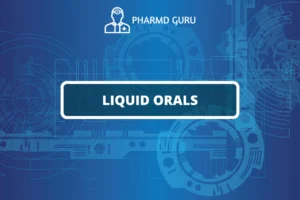Ophthalmic preparations in the form of semi-solids are specialized pharmaceutical formulations used for ocular administration. They play a crucial role in the treatment of various eye conditions, such as infections, inflammation, and dryness. In this article, we will explore the introduction and classification of ophthalmic preparations, factors affecting absorption, the anatomy of the skin, packaging, storage, and labeling. We will also discuss different types of ointment bases, the preparation of ointments, types of jellies, formulation techniques for jellies, and suppositories used in ophthalmic applications.
SCROLL DOWN TO THE BOTTOM OF THIS PAGE FOR ACTUAL NOTES.
Table of Contents
- Introduction to Ophthalmic Preparations (Semi-Solids)
- Classification of Ophthalmic Preparations
- Factors Affecting Absorption and the Anatomy of Skin
- Packaging, Storage, and Labeling
- Ointments: Types of Ointment Bases and Preparation
- Jellies: Types and Formulation
- Suppositories: Method of Preparation and Types
- Packaging of Ophthalmic Preparations
1. Introduction to Ophthalmic Preparations (Semi-Solids)
Ophthalmic preparations in the form of semi-solids are specifically designed pharmaceutical formulations for ocular administration. These dosage forms include ointments, jellies, and suppositories, which are applied topically to the eye or inserted into the conjunctival sac. Ophthalmic semi-solids allow for localized treatment and are commonly used to deliver medications to the eyes.
2. Classification of Ophthalmic Preparations
Ophthalmic preparations can be classified based on their formulation and intended use. Some common classes of ophthalmic preparations include:
- Antibacterial Preparations: These ophthalmic formulations contain antibiotics and are used to treat bacterial eye infections.
- Anti-inflammatory Preparations: These preparations help reduce inflammation in the eyes and provide relief from eye irritation and allergic reactions.
- Lubricating Preparations: Lubricants are used to alleviate dryness and discomfort in the eyes.
- Antiglaucoma Preparations: These formulations are designed to lower intraocular pressure and manage glaucoma.
3. Factors Affecting Absorption and the Anatomy of Skin
Several factors influence the absorption of ophthalmic preparations:
- Drug Properties: The physicochemical properties of the drug, such as its molecular weight, solubility, and lipophilicity, affect its absorption and penetration into the ocular tissues.
- Formulation Factors: The formulation of the ophthalmic preparation, including the type of base and viscosity, can influence drug release, bioavailability, and absorption.
- Ocular Anatomy: The anatomy of the eye, including the cornea, conjunctiva, and eyelids, plays a significant role in the absorption of ophthalmic preparations. The cornea acts as a primary barrier for drug absorption, while the conjunctiva and eyelids can facilitate absorption.
- Tear Film: The tear film covering the ocular surface can affect the residence time and bioavailability of ophthalmic preparations.
- Ocular Blood Flow: Adequate blood flow to the ocular tissues ensures efficient drug absorption and distribution.
4. Packaging, Storage, and Labeling
Proper packaging, storage, and labeling are essential for ophthalmic preparations to maintain their quality, efficacy, and patient safety. Considerations for packaging, storage, and labeling include:
- Packaging: Ophthalmic preparations are typically packaged in sterile and tightly sealed containers to prevent contamination and maintain product integrity.
- Storage: Ophthalmic preparations should be stored in accordance with the manufacturer’s instructions, taking into account temperature, light exposure, and shelf-life considerations.
- Labeling: Clear and comprehensive labeling is necessary for ophthalmic preparations, including the drug name, strength, dosage form, instructions for use, expiration date, and any necessary warnings or precautions.
5. Ointments: Types of Ointment Bases and Preparation
Ophthalmic ointments are semi-solid preparations used for their lubricating properties and prolonged drug release. They consist of an ointment base, drug substance, and other excipients. Common types of ointment bases used in ophthalmic preparations include:
- Anhydrous Bases: Anhydrous ointment bases, such as white petrolatum and mineral oil, are used for lipophilic drugs.
- Absorption Bases: Absorption bases, such as hydrophilic ointment and anhydrous lanolin, are used for hydrophilic drugs and offer good drug release and absorption properties.
The preparation of ophthalmic ointments involves incorporating the drug substance into the ointment base through techniques such as levigation, fusion, or incorporation of pre-dissolved drug solutions.
6. Jellies: Types and Formulation
Ophthalmic jellies are clear and viscous formulations used for lubrication and prolonged drug release. They adhere well to the ocular surface. Common types of jellies used in ophthalmic applications include:
- Carbomer Jellies: Carbomer-based jellies are prepared by dispersing carbomer polymers in a suitable vehicle. They provide excellent lubrication and drug release properties.
- Cellulosic Jellies: Cellulosic jellies, such as hydroxypropyl methylcellulose (HPMC), are widely used due to their viscosity, clarity, and good compatibility with ocular tissues.
- Povidone-Iodine Jellies: Povidone-iodine jellies have antiseptic properties and are used for ophthalmic surgical procedures.
The formulation of ophthalmic jellies involves dispersing the polymer in a suitable vehicle, adjusting the pH, and incorporating the drug substance and other excipients as needed.
7. Suppositories: Method of Preparation and Types
Ophthalmic suppositories are solid dosage forms inserted into the conjunctival sac for local drug delivery. They melt or dissolve upon contact with ocular fluids, releasing the drug substance. Common types of ophthalmic suppositories include:
- Lipid-Based Suppositories: Lipid-based suppositories are prepared using lipophilic bases, such as cocoa butter or hydrogenated vegetable oil. They provide sustained drug release.
- Gelatin-Based Suppositories: Gelatin-based suppositories, also known as gelatin inserts, are composed of gelatin, glycerin, and water. They offer good bioadhesive properties and can adhere to the ocular surface.
The preparation of ophthalmic suppositories involves melting the suppository base, incorporating the drug substance and other excipients, and pouring the mixture into suitable molds for solidification.
8. Packaging of Ophthalmic Preparations
Ophthalmic preparations are typically packaged in sterile and tightly sealed containers to maintain their sterility and integrity. Common packaging materials include plastic tubes, bottles, and single-dose unit containers. The choice of packaging material depends on factors such as compatibility with the formulation, ease of dispensing, and protection from light and contamination.
ACTUAL NOTES:




